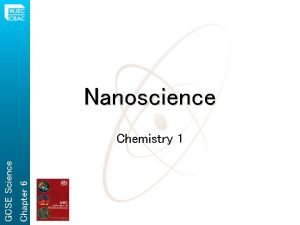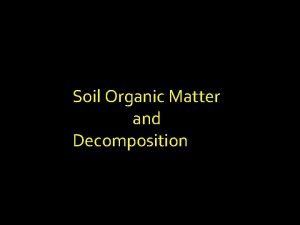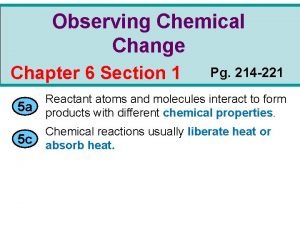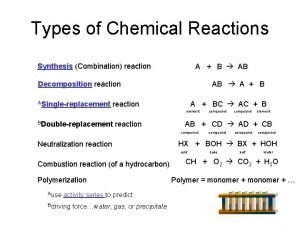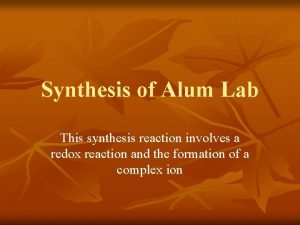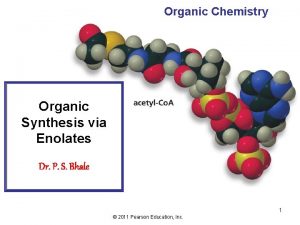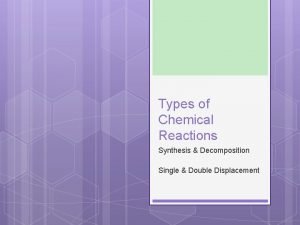Nanoparticle Synthesis Wet Chemistry Hightemperature decomposition of organic











- Slides: 11

Nanoparticle Synthesis Wet Chemistry High-temperature decomposition of organic precursors Attrition Pyrolysis RF Plasma Pulsed Laser Method Biosynthesis …. .

Liquid phase synthesis Precipitating nanoparticles from a solution of chemical compounds can be classified into five major categories: (1) colloidal methods; (2) sol – gel processing; (3) microemulsions method; (4) hydrothermal synthesis; (5) polyol method. Solution precipitation relies on the precipitation of nanometer-sized particles within a continuous fluid solvent. An inorganic metal salt, such as chloride, nitride and so on, is dissolved in water. Metal cations exist in the form of metal hydrate species, for example, Al(H 2 O)3+ or Fe(H 2 O)63+. These hydrates are added with basic solutions, such as Na. OH or NH 4 OH. The hydrolyzed species condense and then washed, filtered, dried and calcined in order to obtain the final product.

Colloidal Chemical Methods Colloidal methods are simple, easy, cheap and well established wet chemistry precipitation processes in which solutions of the different ions are mixed under controlled temperature and pressure to form insoluble precipitates. For metal nanoparticles the basic principles of colloidal preparation were known since antiquity. E. g. gold colloids used for high quality red and purple stained glass from medieval times to date. However, proper scientific investigations of colloidal preparation methods started only in 1857 when Faraday has published results of his experiments with gold. He prepared gold colloids by reduction of HAu. Cl 4 with phosphorus. Aggregation is prevented by electrostatic repulsion or the introduction of a stabilizing reagent that coats the particle surfaces. Particle sizes range from 1 -200 nm and are controlled by the initial concentrations of the reactants and the action of the stabilizing reagent.

Precipitation/coprecipitation Mg 2+(aq) + 4 H 2 O Mg(OH)2 +2 H 3 O+(aq) Kps = [Mg 2+ ][OH-]2 = 1, 8 x 10 -11 Fine tuning of p. H to avoid consecutive precipitation Metal precursors chlorides, nitrates, acetate, . . Precipitating agents, Na. OH, NH 4 OH, Na 2 CO 3…. Precipitate must - Be cheap: - have low solubility; - be easy to decompose; - lead to safe decomposition. 4

Solubility : RT and atm P

Solubility : effect of temperature

Solubility : effect of p. H

Solubility : Complex formation

Precipitation/coprecipitation Precipitation occurs in three steps i) supersaturated solution; ii) nucleation; iii) grain growth The solubility curve is a function of temperature and concentration (p. H); the supersaturated solution is unstable. The supersaturated conditions can be obtained by solvent evaporation, by dropping the temperature or by increasing the p. H of the solution. • Saturated solution: A solution that contains the maximum amount of a solute that can be dissolved at equilibrium at a given temperature. • Unsaturated solution: A solution that contains less than the maximum amount of a solute that can be dissolved at a given temperature. • Supersaturated solution: A solution that contains more than the maximum amount of a solute that can be dissolved under equilibrium conditions at a given temperature. When a supersaturated solution is disturbed in any way, the excess solute will separate and the equilibrium solubility is restored.

Precipitation /co-precipitation • • Nucleation = the appearance of «solid nuclei» in the solution. It can be homogeneous (agglomeration of ions from the pure solution) or heterogeneous (crystallization agents). The dimension of the final nanoparticles depends on the ration between the rates of nucleation and growth, and on the possible aging strategies. • nucleation growth primary time Induced /secondary • • The rate of nucleation depends on the level of supersaturation (easier preparation with low solubility compounds) Highly soluble compounds leads to a rapid dissolution of the smallest nanoparticles followed by deposition on the largest nanoparticles with the obtainment of large precipitate.

Precipitation /co-precipitation
 Advantages and disadvantages of nanoparticles gcse
Advantages and disadvantages of nanoparticles gcse Wet wet wet
Wet wet wet A level chemistry ocr organic synthesis
A level chemistry ocr organic synthesis Ib organic chemistry
Ib organic chemistry Inorganic vs organic chemistry
Inorganic vs organic chemistry Decomposition of organic compounds
Decomposition of organic compounds Observing chemical change
Observing chemical change Opposite of synthesis reaction
Opposite of synthesis reaction Examples of combination reactions
Examples of combination reactions Synthesis decomposition single replacement
Synthesis decomposition single replacement Organic synthesis via enolates
Organic synthesis via enolates Combination reaction
Combination reaction
